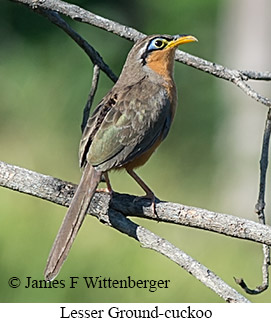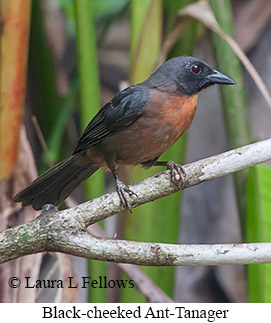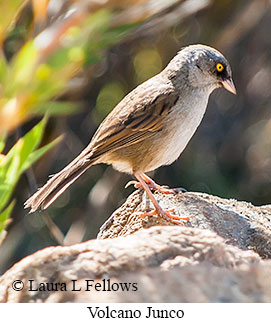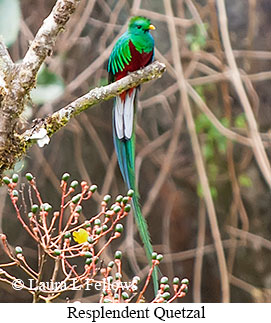SOUTHERN COSTA RICA BIRDING TOUR
Tour Description

COSTA RICA
BIRDING TOUR
ANY TIME*
| Duration: | 9 days, 8 nights |
| Group Size: | 2-8 |
| Anytime Price: | $3495 |
| Group Price: | $3195 |
| Single Suppl: | $350 |
| Est #Species: | 275-325 |
| Pace: | Easy |
| Difficulty: | Easy |
| * This tour is available for any dates of your choosing provided guide services and accommodations are available. | |
DAY 1 - ALAJUELA
International flights arrive in the afternoon or evening. After arrival, transfer to nearby Hotel Aeropuerto, a 5-minute taxi ride from the international airport. Night in Alajuela.
DAY 2 - OROTINA & TARCOLES
Early departure for Orotina. Meet with local guide who usually has stakeouts for Lesser Ground-Cuckoo, Barn Owl, Spectacled Owl, Ferruginous Pygmy-Owl, and Black-and-white Owl. In December and January he may also have a site for the very difficult Rufous-necked Wood-Rail in the mangroves near Caldera. Also possible there is Mangrove Hummingbird. Look for White-throated Magpie-Jay, which is at the very southern end of its range there. After arrival and check-in, do some birding around the lodge. Likely species include Cinnamon Hummingbird, Turquoise-browed Motmot, Hoffmann's Woodpecker, Lesser Greenlet, Rufous-naped Wren, and Melodious Blackbird.
Afternoon can be spent birding in Carara National Park or taking a boat trip on the Tarcoles River (participants' choice). The park is in a transitional zone between northern and southern Pacific coastal areas and attracts a nice combination of northern and southern species. In Carara the headquarters trail through primary forest may yield Great Tinamou, Black-faced Antthrush, Streak-chested Antpitta, Bronzy Hermit, and Riverside Wren along with other species. The alternative is to take a boat trip up the Tarcoles River. Likely species include Fasciated Tiger-Heron, Common Black-Hawk, Amazon Kingfisher, and Double-striped Thick-knee. Around the river mouth are Mangrove Hummingbird, Panama Flycatcher, Mangrove Vireo, and Mangrove Warbler, a color morph of the Yellow Warbler. Back at the lodge, Scarlet Macaws typically visit the gardens in late afternoon, offering close-up viewing. Night at Cerro Lodge.
DAY 3 - CARARA NATIONAL PARK & OSA PENINSULA
Morning bird Carara National Park. The Laguna Meandrica trail through secondary forest paralleling the Tarcoles River. This trail is wide and fairly level, affording easy walking. Specialties typically seen along the trail include White-whiskered Puffbird, Baird's Trogon, Black-hooded Antshrike, Orange-collared Manakin, Rufous-naped Wren, Black-bellied Wren, Rufous-and-white Wren, Scarlet-rumped Tanager, and Spot-crowned Euphonia. With luck one could also find Long-tailed Manakin and Rufous-breasted Wren. At the end of the trail are some ponds where roosting Boat-billed Herons are normally present in thick understory near the river. Then depart for Osa Peninsula. A stop near Quepos is a good place to find the very localized Spot-fronted Swift along with the more widely distributed Costa Rican Swift. Arrive at the lodge late afternoon. Check the feeders near the lodge for Black-cheeked Ant-Tanager, by far the best place in Costa Rica to view this normally quite secretive species. Night at Bosque del Rio Tigre.
DAYS 4-5 - BOSQUE DEL RIO TIGRE
Two full days birding trails near the lodge and nearby Corcovado National Park. An optional early excursion a short distance up the trail above the lodge before dawn one morning may produce the quite elusive Scaly-throated Leaftosser. A trail behind the lodge goes up a ridgeline through good forest before reaching a jeep track used by locals and miners. Birds of note include Gray-chested Dove, Little Hermit, Slaty-tailed Trogon, Baird's Trogon, Gartered Trogon, Black-throated Trogon, White-whiskered Puffbird, Olivaceous Piculet, Golden-naped Woodpecker, Red-crowned Woodpecker, Pale-billed Woodpecker, Red-lored Parrot, Black-hooded Antshrike, Dot-winged Antbird, Chestnut-backed Antbird, Streak-headed Woodcreeper, Buff-fronted Foliage-gleaner, Northern Royal-Flycatcher, Sulphur-rumped Flycatcher, Turquoise Cotinga, Orange-collared Manakin, Black-crowned Tityra, Masked Tityra, Flame-throated Warbler, and Black-striped Sparrow. Raptors such as Black Hawk-Eagle, Ornate Hawk-Eagle, and Tiny Hawk are possible. Back at the lodge, feeding stations outside the dining area typically attract Little Tinamou, Blue Ground-Dove, Scarlet-rumped Tanager, and Orange-billed Sparrow in addition to Black-cheeked Ant-Tanager. Birds such as Band-tailed Barbthroat, Blue-throated Goldentail, Fiery-billed Aracari, Yellow-bellied Tyrannulet, Yellow Tyrannulet, Yellow-olive Flycatcher, and Green Shrike-Vireo can be seen around the lodge. One afternoon drive into the village of Tigre to look for Isthmian Wren. An optional uphill trail into Corcovado National Park outside town offers Ruddy Quail-Dove, Great Antshrike, Golden-crowned Spadebill, Rufous Piha, Red-capped Manakin, and White-throated Shrike-Tanager. At dusk, several Black-faced Antthrushes reliably come out to feed around the compost piles near the lodge. Nights at Bosque del Rio Tigre.
DAY 6 - RINCON & TALAMANCA HIGHLANDS
Depart early for the Rincon River, arriving by 6:30-7:00am. This site is a reliable place to see Yellow-billed Cotingas, which perch in treetops and fly among the trees on either side of the bridge over the river in early morning. From there transfer to the Talamanca Highlands, stopping en route for birding and lunch. A visit to the antenna area atop Cerro de la Muerte should produce several high elevation specialties, notably Volcano Hummingbird, Timberline Wren, Peg-billed Finch, Sooty-capped Chlorospingus, Volcano Junco, and Large-footed Finch. After arrival and check-in, visit the lodge's new hummingbird gardens. Species likely there include Green-crowned Brilliant, Magnificent Hummingbird, Scintillant Hummingbird, and Gray-tailed Mountain-gem. Also likely is Slaty Flowerpiercer feeding among the flowers. Along the road, a stretch of flowers reliably attracts Stripe-tailed Hummingbird. Night at Savegre Mountain Hotel.
DAY 7 - SAN GERARDO DE DOTA & TALAMANCA HIGHLANDS
Optionally, do a very early departure and excursion to Paraiso Quetzales, where they have a program for getting good views of Resplendent Quetzals on a local finca. Then view hummingbirds coming to feeders near Paraiso Quetzales Lodge. This site is the best place to see Fiery-throated Hummingbird, a high elevation species not normally present in the valley. Alternatively, bird the road looking for quetals followed by birding the river trail where quetzals and other highland specialties are possible. Afternoon visit the hummingbird gardens at Savegre Mountain Hotel, which attracts a variety of highland hummingbirds. Night at Savegre Mountain Hotel.
DAY 8 - SAN GERARDO DE DOTA & SAN JOSE
Morning drive high up the mountain behind the lodge and bird the trail going back down. Certainly the prime attraction is Resplendent Quetzal, often seen in the forest there. Other highland species of note include Spotted Wood-Quail, Ruddy Pigeon, Barred Parakeet, Sulphur-winged Parakeet, Lineated Foliage-gleaner, Streak-breasted Treehunter, Ruddy Treerunner, Mountain Elaenia, Yellow-winged Vireo, Black-faced Solitaire, Black-billed Nightingale-Thrush, Long-tailed Silky-Flycatcher, Black-cheeked Warbler, Wrenthrush, Spangle-cheeked Tanager, Silver-throated Tanager, Peg-billed Finch, and Flame-colored Tanager. Afternoon transfer back to Alajuela, arriving by late afternoon. Night at Hotel Aeropuerto.
DAY 9 - END OF TOUR
Tour ends with breakfast at the hotel. International flights home.
ADDITIONAL INFO
(Not on Menu Above)
BIRDING LOCALES











